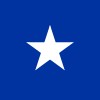Chilean Navy
|
Chilean Navy ''Armada de Chile'' |
|
|---|---|

Coat of arms of the Chilean Navy
|
|
| Active | 1817–present |
| Country |
|
| Size | 25,000 personnel 71 vessels 8 frigates 4 submarines 4 amphibious warfare ship 3 fast attack craft 8 patrol boat 4 corvettes 39 auxiliary ship |
| Motto(s) |
Vencer o Morir ("Conquer or Die") |
| March | Brazas a ceñir (Braces to be close-hauled) by WO1 Luis Mella Toro (Official hymn) |
| Anniversaries | 21 May, Día de las Glorias Navales (Navy Day) |
| Engagements |
Chilean War of Independence Peruvian War of Independence War of the Confederation Chincha Islands War War of the Pacific Panama Crisis of 1885 1891 Chilean Civil War 1978 Beagle Canal Conflict |
| Commanders | |
| Commander in Chief of the Navy | Admiral Enrique Larrañaga Martin |
| Notable commanders |
Lord Thomas Cochrane Manuel Blanco Encalada Juan José Latorre Arturo Prat Jorge Montt Juan Williams Rebolledo |
| Insignia | |
| Naval Ensign |  |
| Naval Jack |  |
| Roundel of Naval Aviation |  |
The Chilean Navy (Armada de Chile) is the naval force of Chile.
The origins of the Chilean Navy date back to 1817, when General Bernardo O'Higgins prophetically declared after the Chilean victory at the Battle of Chacabuco that a hundred such victories would count for nothing if Chile did not gain control of the sea.
This led to the development of the Chilean Navy, and the first legal resolutions outlining the organization of the institution were created. Chile's First National Fleet and the Academy for Young Midshipmen which was the predecessor of the current Naval Academy were founded, as well as the Marine Corps and the Supply Commissary.
The first commander of the Chilean Navy was Manuel Blanco Encalada. However the famous British naval commander Lord Cochrane who formerly had been a Captain in the Royal navy, was hired by Chileans to organize and command the Navy. Cochrane recruited an almost all-anglophone complement of officers and midshipmen and crews of British, Irish and American seamen. He became a key figure in the war against loyalist forces in Peru and was instrumental in taking control of the fortresses of Valdivia even though he failed in his attempt to conquer Chiloé Island.
In March 1824, the Chilean Navy and Army undertook an expedition to expel the Spanish from Chiloé Archipelago. An expedition was dispatched to Chiloé Island however ended in failure when the Chilean Army led by Jorge Beauchef was defeated at the Battle of Mocopulli. It was only after Ramón Freire's Chiloé expedition in 1826 did the royalist forces at Chiloé under the command of Antonio de Quintanilla, surrender and Chiloé joined the new Chilean nation.
...
Wikipedia
